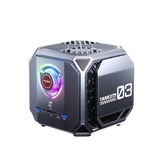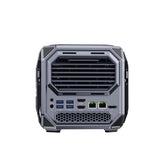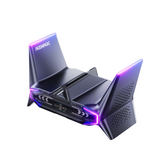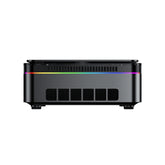Mini PC for Home Theater: Why It’s Still the Smartest Choice

What Is a Home Theater PC (HTPC)?
HTPC Defined: A Hybrid of Power and Entertainment
A Home Theater PC, commonly referred to as an HTPC, is a compact and specialized computer designed to manage and play digital media—such as movies, music, TV shows, and even live streaming—in a living room setup. Unlike standard desktops or laptops that serve general computing needs, HTPCs are fine-tuned for high-quality video and audio playback.
These systems connect directly to your television or projector, acting as the media hub in your entertainment center. Their primary strengths lie in format compatibility, high-resolution support (including 4K and Blu-ray), and versatile media storage options. Whether you're watching a movie, streaming your favorite series, or showcasing your photo archive, an HTPC provides a centralized and seamless experience.
Brief History and Evolution Since the 2000s
HTPCs began gaining popularity in the early 2000s when consumers started converting their desktops into all-in-one media systems. At the time, they were often bulky and noisy. However, advances in hardware miniaturization and more efficient cooling solutions have shifted the trend toward compact, silent devices that can handle streaming, decoding, and playback smoothly—leading to the rise of the Mini PC.
Is an HTPC Worth the Investment?
Despite the proliferation of smart TVs and streaming devices, many users still find HTPCs to be a smart investment for their home entertainment systems. Here's why:
- Compact and living room-friendly: HTPCs are small enough to fit on shelves or behind displays, requiring minimal space.
- Affordable media power: Building or buying an HTPC can cost less than a high-end smart TV or a premium streaming device.
- Stable media experience: Unlike smart TVs, which may suffer from software limitations, HTPCs offer full access to any software, file format, or codec you may need.
An HTPC supports more than entertainment. It contributes to the atmosphere of the home—family movie nights, music playlists during gatherings, and curated video collections become easily accessible and organized through one device.
Build Your Home Theater PC
If you prefer a DIY approach, building your HTPC from individual components allows full control over its features and performance. Below is a comparison of essential components to help you get started:
| Component | Recommended Specification | Why It Matters |
|---|---|---|
| CPU | Intel i5/Ryzen 5 or better | Efficient media decoding, 4K support |
| RAM | 8GB–16GB DDR4 | Ensures smooth playback and multitasking |
| Storage | 512GB SSD + optional HDD | Fast OS/media loading and ample storage |
| GPU | Integrated or low-profile GPU | Only necessary for gaming or 3D video |
| Cooling | Low-noise or fanless solution | Keeps system quiet in the living room |
| Case | Compact HTPC or Mini-ITX case | Saves space and blends into home setups |
After selecting the right parts, installing media center software such as Kodi, Plex, or Jellyfin allows your HTPC to organize, stream, and play content intuitively.
But for many users, pre-built Mini PCs offer a faster, easier, and more efficient path to building an HTPC setup—without any manual assembly.
Why Choose a Mini PC as Your Home Theater PC?
Mini PCs have emerged as the most popular HTPC form factor. Here's why they make sense for nearly any home theater system:
- Compact Yet Powerful: Despite their small footprint, modern mini PCs are equipped with capable processors, fast memory, and solid-state storage that deliver fluid media performance—even for 4K content.
- Quiet Operation: Many Mini PCs are built with low TDP (thermal design power) processors and fanless cooling systems, making them nearly silent—ideal for movie nights.
- Energy-Efficient: Mini PCs consume much less power than tower desktops. Many models operate below 20W even during video playback, contributing to long-term energy savings.
- Easy to Hide or Mount: Thanks to VESA-mount compatibility, Mini PCs can be mounted behind a monitor or TV, keeping your setup clean and clutter-free.
- Multi-Purpose Capability: While built for media, Mini PCs can also be used for browsing, video calls, or connecting to smart devices, providing flexibility beyond just entertainment.
Key Features to Look for in a Modern HTPC Setup
Essential Hardware Components
- Processor (CPU): Look for models with integrated graphics like Intel Iris Xe or AMD Vega. These handle 4K playback without a discrete GPU.
- Memory (RAM): 8GB is the baseline; 16GB is better for those running multiple media apps or multitasking.
- Storage: SSDs offer fast boot and access times. Pair with an external HDD if your media library is extensive.
Living Room–Friendly Design
Choose a mini PC with low heat output, quiet fans, and a black or silver chassis that blends in with your entertainment unit.
Mini PC vs Other HTPC Solutions
| Option | Pros | Cons |
|---|---|---|
| Mini PC | Compact, powerful, affordable, low-noise | Limited internal expandability |
| Smart TV | Built-in apps, no extra devices | Limited formats, update cycles, weaker processors |
| Streaming Boxes (e.g. Fire TV) | Inexpensive, easy setup | No local media storage, less customization |
| Traditional Tower HTPC | Highly upgradeable, powerful | Bulky, higher power consumption, noisier |
Streaming and Media Software Support
Mini PCs support all major home theater software:
- Kodi: Great for local libraries and plugins
- Plex: Best for managing large media collections and streaming to multiple devices
- Jellyfin: Open-source option with wide format support
- VLC: Lightweight and reliable media player
- Netflix, Disney+, YouTube, Amazon Prime: All accessible via browser or app on Windows-based mini PCs
You can also install IR receivers or use Bluetooth-based remotes and smartphone apps to control playback comfortably from the couch.

Recommended Mini PCs for Home Theater Use
Choosing the right Mini PC for HTPC usage can be challenging if you're not sure what to prioritize. Below are three carefully selected models that cater to different preferences and budgets—each with distinct advantages for home entertainment.
Apple Mac Mini (M4)
The Apple Mac Mini (M4) is a compact yet highly capable machine for home theater setups. Equipped with a 10-core CPU, 10-core GPU, and a 16-core Neural Engine, it handles high-resolution video playback with ease. Its built-in media engine supports hardware-accelerated decoding for HEVC, AV1, and ProRes, making it ideal for streaming 4K content or managing a personal media library.
The device supports up to three displays, including 8K or high-frame-rate 4K output, and is compatible with Dolby Vision, HDR10+, and Dolby Atmos. Whether you're using a soundbar or surround system, the HDMI port enables multichannel audio output, and the 3.5mm headphone jack offers advanced support for high-impedance headphones.
While it comes at a premium, the Mac Mini (M4) offers a polished, silent, and reliable HTPC experience—especially for users already in the Apple ecosystem.
Intel NUC 13 Pro
Intel's NUC (Next Unit of Computing) series has long been a favorite among HTPC enthusiasts, and the latest NUC 13 Pro models continue to impress. These mini PCs offer a strong mix of performance, reliability, and flexibility.
Equipped with 13th Gen Intel Core i5 or i7 processors, the NUC 13 Pro supports dual HDMI outputs, Thunderbolt 4, Wi-Fi 6E, and up to 64GB of DDR4 RAM (user-upgradeable). The chassis remains small enough for VESA mounting, while the internal design allows for easier upgrades compared to most mini PCs.
The pricing is moderate—more affordable than Mac Mini in many cases—making it a solid middle-ground choice. It's well-suited for users who want long-term stability, strong connectivity, and the option to tinker with upgrades later on.
ACEMAGIC V1 (Intel Twin Lake N150)
For users looking to build a budget-friendly yet efficient home theater setup, the ACEMAGIC V1 offers a solid foundation. It's powered by the Intel Twin Lake N150 processor, with 4 cores, Turbo boost up to 3.6GHz, and integrated Intel Graphics (24 EUs) capable of smooth 4K video playback at 60Hz via HDMI 2.0 or DisplayPort 1.4.
This model comes in variants with 8GB or 16GB DDR4 RAM and 256GB to 1TB SSD storage, and supports up to 2TB M.2 SSDs, offering flexibility for media libraries. It includes a Gigabit Ethernet port, Wi-Fi 5, and Bluetooth 4.2, covering most modern connectivity needs.
Despite its compact size (just 10×10×3.3cm), it features multiple USB ports (USB 3.2 Gen 2 and USB 2.0), a 3.5mm audio jack, and runs Windows 11 Pro out of the box—making it ready for media center applications like Plex, VLC, or Kodi.
As part of ACEMAGIC's growing lineup of mini PCs, the V1 is a practical choice for families, students, and entertainment enthusiasts alike. Its compact design, solid performance, and accessible price make it one of the most balanced HTPC options available—especially for users who want reliable quality backed by a dedicated mini PC brand.
Setup Guide: Turning a Mini PC into an HTPC
Step-by-Step Overview
-
Connect Hardware
Use HDMI to connect the mini PC to your TV or AV receiver. Connect external audio devices via 3.5mm, SPDIF, or Bluetooth. -
Install Software
Install your OS (typically Windows 11) and download Kodi, Plex, VLC, or your preferred media software. -
Configure Playback Settings
Set the resolution to match your TV (4K/60Hz recommended), and configure audio output for stereo or surround sound. -
Remote Access
Use wireless keyboards, Bluetooth remotes, or smartphone apps to control playback without moving from the couch. -
Optimize Power Settings
Adjust sleep, wake-on-LAN, and boot settings for a seamless home theater experience.
FAQs About Mini PCs for Home Theater
What is the main benefit of using a Mini PC as a Home Theater PC?
A Mini PC offers a compact and quiet solution that supports high-quality video and audio playback. It connects easily to your TV or AV system, allowing you to stream, store, and organize your media library in one device without taking up much space.
Do I need a graphics card for a Mini HTPC?
Not usually. Most modern Mini PCs come with integrated graphics (like Intel Iris Xe or AMD Radeon Vega) that are fully capable of handling 4K video playback and streaming. A discrete GPU is only necessary if you plan to play modern PC games or perform advanced 3D rendering.
How much RAM is enough for an HTPC?
8GB of RAM is sufficient for smooth 4K playback and typical home theater use. However, if you plan to run background tasks, host media server software like Plex, or multitask, 16GB offers more breathing room.
Can I stream Netflix, YouTube, and Disney+ on a Mini PC?
Yes. Any Mini PC running Windows, macOS, or a full Linux distro can access popular streaming platforms via web browsers or dedicated apps. Unlike some streaming sticks, Mini PCs offer better compatibility with browser extensions and ad blockers.
Is a Mini PC hard to set up as a home theater system?
No. Setting up a Mini PC typically involves connecting it to your TV via HDMI, plugging in power and network cables (or using Wi-Fi), and installing your preferred media apps. Some users also add a wireless keyboard or remote for easier control.
Can a Mini PC replace a smart TV or streaming box?
Yes. A Mini PC provides much broader functionality than most smart TVs or streaming boxes. It allows you to run any software, play local media files, browse the internet, and control playback more precisely.
Do Mini PCs support surround sound systems?
Many Mini PCs include HDMI 2.0 or 2.1 outputs, which support multi-channel audio formats like Dolby Digital and DTS. Some models also offer SPDIF or 3.5mm audio jacks for more direct connections to speakers and receivers.
Can I store all my movies and music on a Mini PC?
Yes. Most Mini PCs come with SSDs (256GB–1TB), which are fast but limited in size. You can expand storage with external USB drives or set up a NAS (Network Attached Storage) for large media libraries accessible from multiple devices.
Is it possible to control the Mini PC with a remote?
Absolutely. Many Mini PCs support Bluetooth remotes, IR receivers, or even smartphone apps that function as touch remotes. You can also use compact wireless keyboards with trackpads for better navigation.
Which operating system is better for HTPC use: Windows or Linux?
Windows offers broader software support, easier access to streaming services, and better compatibility with remotes and drivers. Linux (e.g., Ubuntu, LibreELEC) works well for dedicated media centers using Kodi but may require more technical setup.

Conclusion: Mini PCs Are the Future of Home Theater PCs
HTPCs have evolved—today, the mini PC is the smartest way to bring powerful, quiet, and flexible media playback into your home. They're easy to install, integrate well into entertainment systems, and support all the major platforms and formats you use every day. Whether you build one from scratch or choose a pre-built option like ACEMAGIC, a mini PC offers long-term value and a better home theater experience for anyone who wants performance without complexity.








Leave a comment
Please note, comments need to be approved before they are published.